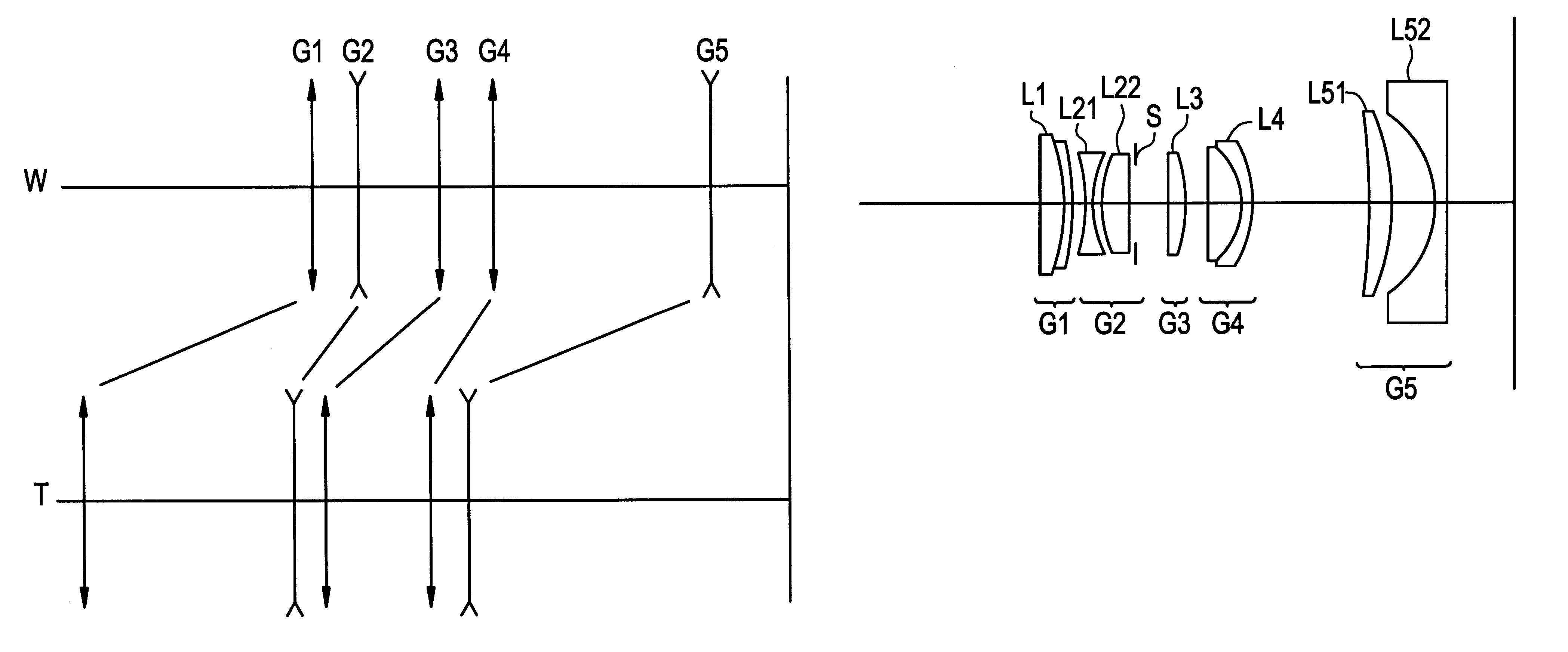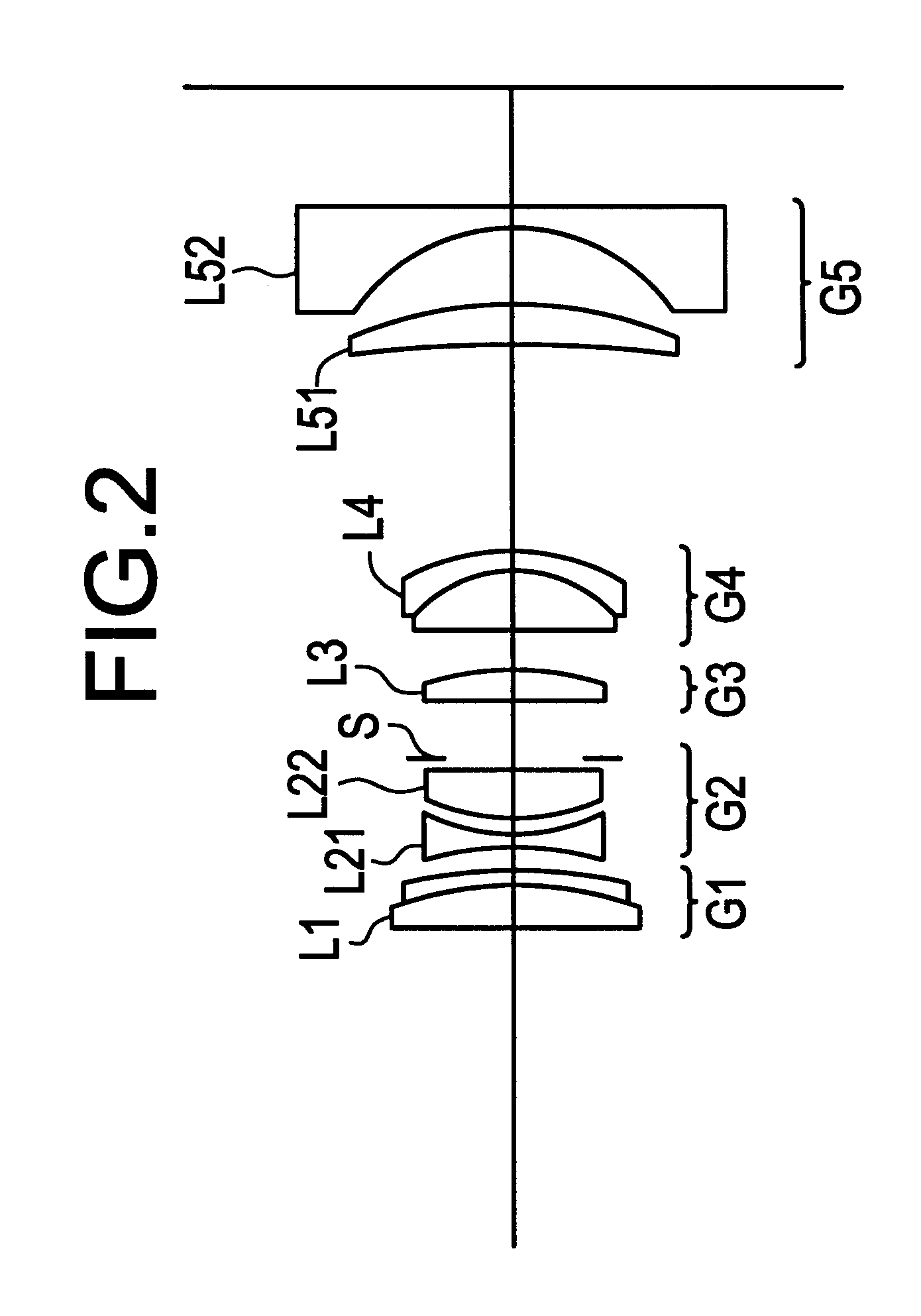Variable focal-length lens system
a lens system and variable technology, applied in the field of zoom lenses, can solve the problems of affecting portability, affecting the performance of the lens, and affecting the length of the overall lens,
- Summary
- Abstract
- Description
- Claims
- Application Information
AI Technical Summary
Problems solved by technology
Method used
Image
Examples
first embodiment
FIG. 2 is a drawing showing the constitution of the lenses in a first embodiment of the present invention, wherein, in order from the object side, a first lens group G1 consists of a cemented positive lens L1 containing a biconvex lens and a negative meniscus lens which presents a concave surface toward the object side, a second lens group G2 consists of a biconcave lens L21 and a biconvex lens L22, a third lens group G3 consists of a biconvex lens L3, a fourth lens group G4 consists of a cemented positive lens L4 containing a biconvex lens and a negative meniscus lens which presents a concave surface toward the object side, and, a fifth lens group G5 consists of a positive meniscus lens L51 which presents a concave surface toward the object side and a negative meniscus lens L52 which presents a concave surface toward the object side.
An aperture stop S is arranged between the second lens group G2 and the third lens group G3, and this aperture stop moves in integral fashion with the ...
second embodiment
FIG. 9 is a drawing showing the constitution of the lenses in a second embodiment of the present invention, wherein, in order from the object side, a first lens group G1 consists of a cemented positive lens L1 containing a biconvex lens and a negative meniscus lens which presents a concave surface toward the object side, a second lens group G2 consists of a biconcave lens L21 and a positive lens L22 which presents a convex surface toward the object side, a third lens group G3 consists of a biconvex lens L3, a fourth lens group G4 consists of a cemented positive lens L4 containing a biconvex lens and a negative meniscus lens which presents a concave surface toward the object side, and a fifth lens group G5 consists of a positive meniscus lens L51 which presents a concave surface toward the object side and a negative meniscus lens L52 which presents a concave surface toward the object side.
An aperture stop S is arranged between the second lens group G2 and the third lens group G3, and...
third embodiment
FIG. 16 is a drawing showing the constitution of the lenses in a third embodiment of the present invention, wherein, in order from the object side, a first lens group G1 consists of a cemented positive lens L1 containing a biconvex lens and a negative meniscus lens which presents a concave surface toward the object side, a second lens group G2 consists of a biconcave lens L21 and a positive lens L22 which presents a convex surface toward the object side, a third lens group G3 consists of a biconvex lens L3, a fourth lens group G4 consists of a cemented positive lens L4 containing a biconvex lens and a negative meniscus lens which presents a concave surface toward the object side, and a fifth lens group G5 consists of a positive meniscus lens L51 which presents a concave surface toward the object side and a negative meniscus lens L52 which presents a concave surface toward the object side.
An aperture stop S is arranged between the second lens group G2 and the third lens group G3, and...
PUM
 Login to View More
Login to View More Abstract
Description
Claims
Application Information
 Login to View More
Login to View More - R&D
- Intellectual Property
- Life Sciences
- Materials
- Tech Scout
- Unparalleled Data Quality
- Higher Quality Content
- 60% Fewer Hallucinations
Browse by: Latest US Patents, China's latest patents, Technical Efficacy Thesaurus, Application Domain, Technology Topic, Popular Technical Reports.
© 2025 PatSnap. All rights reserved.Legal|Privacy policy|Modern Slavery Act Transparency Statement|Sitemap|About US| Contact US: help@patsnap.com



